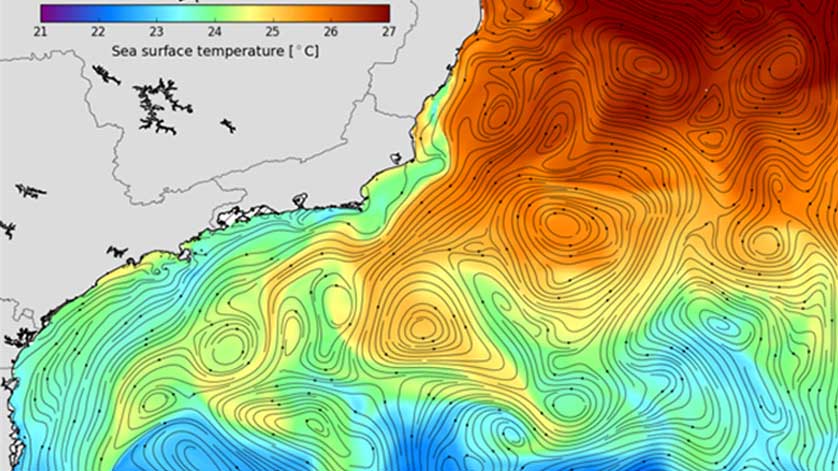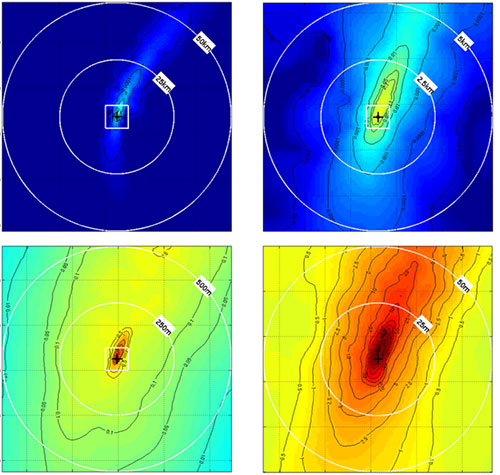Modelling the Dispersal and Settlements of Drill Cuttings

Drilling operations at sea produce a mix of fine rock fragments that need to be discharged into the ocean. While inert, these fragments (known as drill cuttings) can have sediments, contaminants and drilling fluids adhering to them. To help regulators and marine managers assess the potential impact of drilling operations, MetOcean Solutions is regularly engaged to model the dispersal and settlement of drill cuttings in the marine environment at locations all over the world.
“Drill cuttings settle on the seabed, where they can cause adverse environmental impacts,” explains Oceanographer Remy Zyngfogel. “The oceanic discharge of drill cuttings occurs over specific time periods, but their dispersal and deposition are driven by random variables such as currents and turbulence.”
“To determine where the drill cuttings end up on the seabed, we use a variety of methods and leverage the expertise of our multidisciplinary science team. This includes modelling the hydrodynamics of the region and simulating the trajectory and the settling of the drill cuttings to the seabed. Regulators and marine managers require good knowledge of the likely footprint of deposition and how thick the deposits will be at increasing distances from the drill site.”
Project Director Dr. Brett Beamsley oversees the hydrodynamic modelling. “We use different models to produce the historical datasets needed for the studies,” advises Brett. “Oceanic and coastal currents vary according to synoptic and seasonal winds, tides and density differences. To account for this variability, and to provide robust statistical estimates of dispersal and deposition, we use historical data to recreate the actual oceanographic conditions, typically hour-by-hour for a 10-year period. We recreate these currents using the most appropriate model. For offshore studies, we use the Regional Ocean Modeling System (ROMS), whereas for smaller-scale studies at inshore sites SCHISM or Delft3D are used.”
Remy uses the historical current dataset to determine the dispersal of drill cuttings. “Once we have the historical currents, we use a particle tracking model to trace the dispersal and deposition of drill cuttings for simulated discharges at different times of the year,” he explains. “Ocean currents vary with factors like seasonal winds and riverine discharges, so the depositional footprint will differ depending on which time of year the drilling is done. The size of fragments discharged into the sea depends on the rock type and the drill bit design. From an estimate of particle size, we can determine settling velocities - the finest fractions of the drill cuttings settle through the water column very slowly and become widely dispersed, whereas larger particles settle quickly and much closer to the discharge location.”
 Example deposition thickness for drill cuttings discharged from a marine location. The spatial distributions of deposition thickness are color-coded with values in mm on each contour line in four zoom views: 100x100 km (top left), 10x10 km (top right), 1x1 km (bottom left) and 100x100 m (bottom right). The release site is indicated as a black cross.
Example deposition thickness for drill cuttings discharged from a marine location. The spatial distributions of deposition thickness are color-coded with values in mm on each contour line in four zoom views: 100x100 km (top left), 10x10 km (top right), 1x1 km (bottom left) and 100x100 m (bottom right). The release site is indicated as a black cross.
“The modelling represents what is likely to happen statistically, over long time periods. Naturally, for any given discharge, the drill cuttings will disperse according to the flow conditions at the time. For example, if discharge occurs during high current flows, the drill cuttings will be transported further, and the deposition will be more spread out. If current velocities are low at the time of discharge, the cuttings will accumulate closer to the discharge point.”
Where pre- and post-drilling sediment samples have been taken, it is possible to verify the dispersal modelling.
“We often use barium as a tracer,” explains Remy. “Drill cuttings contain elevated concentrations of barium from the drilling fluids. This makes barium an ideal tracer of discharged cuttings. Seabed samples taken before and after drilling can be used to determine the change in barium concentration and thereby verify the modelled deposition of the cuttings.“
“The modelling provides a statistical representation of possible outcomes, taking into account the natural variety of current flow conditions. The modelled results typically show good agreement with observed barium levels, which means that operators and regulators can confidently use the modelling to determine the extent of potential adverse effects. This information is used both when applying for permits and post-permit, in the design of environmental monitoring programs.”

